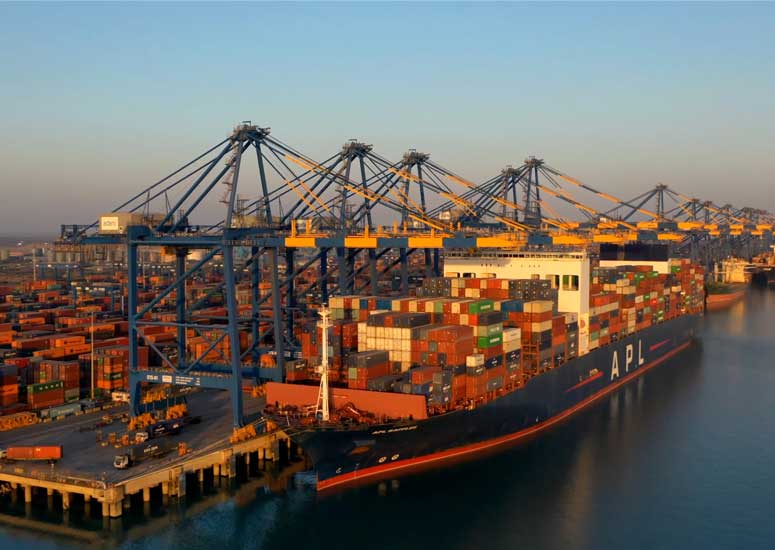
Adani Ports on a new high, registers largest cargo volume of 339 MMT in FY23
- APSEZ records 9% Y-o-Y growth, largest port cargo volumes ever
- Mundra continues to be India’s largest seaport with ~155 MMT of total cargo handled during the year
- APSEZ’s deep draft ports can receive larger vessel parcels, thereby lowering overall logistics cost
- Improved port and logistics infrastructure key to India becoming $5 trillion economy
AHMEDABAD : Adani Ports and Special Economic Zone Ltd (APSEZ), the largest integrated transport utility in India and a part of the diversified Adani Group, handled ~32 MMT of total cargo in March 2023, implying a Y-o-Y growth of ~9.5%. For the first time since July 2022, the volumes crossed the 30-MMT mark. With ~339 MMT in FY23 (April 2022 – March 2023), APSEZ recorded its largest port cargo volumes ever – which is a good ~9% Y-o-Y growth. Adani Ports has been continuously increasing its market share for the past years, outperforming all of India’s cargo volume growth.
“The improvement in cargo volumes is testimony to the faith that our customers have in us,” said Mr Karan Adani, CEO and Whole Time Director, APSEZ. “It shows our commitment to using improved efficiencies and technological integrations to drive and achieve customer satisfaction. The APSEZ’s flagship port, Mundra, is outpacing all its closest rivals and continues to be the largest port in the nation in terms of volumes handled. Mundra’s infrastructure meets world standards and provides service levels on par with those of its global competitors, making it India’s gateway for container goods.”
The overall container volumes handled by APSEZ in India jumped to ~8.6 MTUs (+5% YoY), including ~6.6 MTEUs at Mundra alone. It continues to be India’s largest seaport with ~155 MMT of total cargo handled during the year. The logistics business segment also had a record year. The container rakes handled during the year achieved a new milestone crossing 500,000 TEUs (+ 24% Y-o-Y), while the bulk cargo transported exceeded 14 MMT, implying 62% Y-o-Y jump. This financial year witnessed APSEZ setting some new milestones on the count of ships docked (6,573), rakes serviced (40,482), and the trucks, trailers and tankers handled (48,89,941). Adani Ports serviced 3,068 unique customers across its different business units.
Increase in cargo volume at ports reflects country’s economic prosperity. Almost 95% of the trade volumes in India are carried through maritime transport. So, having world-class mega ports is imperative for the Indian coastline. APSEZ has strategically built a string of ports across the Indian coastline along with ICDs (inland container depots) and warehouses, woven intricately with self-owned rakes, covering around 90% of the country’s hinterland.
The capability to maintain deep draft ports enables APSEZ’s customers bring larger vessel parcels, thereby lowering their overall logistics cost. The lower logistics costs allow businesses to export goods, boosting domestic economy and raising the employment rate in the process. Mundra handled the deepest container vessel – MSC Washington with an arrival draft of 17.0 meters – ever handled by any Indian port, and the largest vessel, MSC Fatma, with a vessel length of 366 m and carrying capacity of 15,194 TEUs. The port also docked its first LNG-fueled vessel, Aframax Crude Oil Tanker, at its SPM facility. The draft is 14 meters long with a total displacement of 1,26,810 MT.
Among India’s ports that can handle cape-size vessels with deeper drafts, Krishnapatnam Port has the highest departure draft recorded in Indian maritime history. A fully loaded cape-size vessel, MV NS Hairun, with a maximum draft of 17.85 meters sailed out from the port with 168,100 MT of iron ore. It received the largest parcel size of gypsum MV SHINYO GUARDIAN with 163,781 MT.
Busy traffic was witnessed at other ports as well with Dahej receiving “MV STAR OPHELIA” carrying 1.24 lakh MT of gypsum cargo, Kattupalli handling the largest dry bulk parcel size vessel, MS Tristar Dugon, with a 76,250 MT discharge of gypsum and Hazira getting the largest over dimensional cargo (OCD) with a volume of 45752 cubic meters.
The engagement with container lines and the resolve to deliver on commitments has led to more new services at APSEZ terminals, raising volumes. While Hazira reported the highest ever sugar cargo volume of 1.15 MMT as compared to its previous best of 0.95 MMT, Krishnapatnam recorded an all- time high gypsum discharge of 1.17 MMT. Gangavaram dispatched the highest amount of alumina bulkers on a single day whereas Dhamra exported 1,57,000 MT of iron ore on MV Mojo, which sailed out with a deep draft of 17 meters, and Kattupalli posted a 58% rise in container volume.
Mundra has the fastest turnaround time for vessels allowing ships to berth immediately. With the focus on improving operational efficiencies along with customer-oriented initiatives, it has achieved remarkable feat and create new benchmarks. It handled highest ever RO-RO volume of 2.09 lakh cars in this financial year as compared to previous high of 1.87 lakh. This rise is the result of the confidence shown by the long-time customer Maruti Suzuki India Limited.
APSEZ consistently works on cargo diversification at all its ports. This year, Krishnapatnam Port successfully added soybeans, edible oil and sugar to its cargo portfolio while Dighi Port handled sugar, for the first time and Dhamra its first rice vessel for export to Bangladesh.
APSEZ’s achievement underlines its ability to adapt to fast-paced changes due to global market and geopolitical volatility and continue its journey towards sustainable growth. Improved port infrastructure means better logistics performance and higher seaborne trade and economic growth, key to India becoming a $5 trillion economy.
